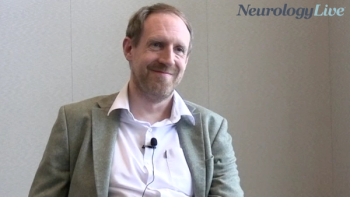
Ponesimod Superior to Teriflunomide in Lowering MS Relapse Rates
New phase 3 data from the OPTIMUM head-to-head trial show that 20-mg ponesimod resulted in a significantly lower annualized relapse rate in adults with multiple sclerosis compared to 14-mg teriflunomide at 108 weeks.
Ludwig Kappos, MD
In new phase 3 data presented at
In the head-to-head OPTIMUM study (NCT02425644), Janssen Pharmaceuticals’ orally active, selective modulator of the sphingosine-1-phosphate receptor 1 had a statistically significant 30.5% greater reduction in annualized relapse rate (ARR) compared to teriflunomide (Aubagio, Sanofi). At week 108, the respective ARRs for the ponesimod and teriflunomide groups were 0.202 and 0.290 (P = .0003).
The data are expected to be used as the foundation of ponesimod’s submission to the FDA and other regulatory agencies as a treatment for relapsing MS, expected to come later this year.
"This is the first large controlled head-to-head study comparing two oral compounds for the treatment of relapsing MS," said Ludwig Kappos, MD, chair, department of neurology, University Hospital of Basel, in a statement. “Notably, we saw the superiority of the investigational agent ponesimod when compared to teriflunomide across the primary and most secondary endpoints.”
Kappos, who presented the data at ECTRIMS, added that “in conjunction with the observed safety profile, [these data] underline the potential of ponesimod as a new treatment option for MS.”
Secondary endpoints included effect on fatigue-related symptoms assessed with Fatigue Symptom and Impact Questionnaire-Relapsing Multiple Sclerosis (FSIQ-RMS), active lesions on MRI to week 108, and time to 12- and 24-week disability accumulation to the end-of-study. The mean baseline Expanded Disability Status Scale (EDSS) score was 2.6 and mean disease duration was 7.6 years, while the mean pre-study 12-month relapse rate was 1.3, and 483 (42.7%) patients had ≥1 Gd+ T1 lesions on their baseline MRI.
FSIQ-RMS—a new MS-specific, 20-item patient-reported outcome measure—scores at week 108 suggested statistically significant effects on fatigue symptoms with ponesimod in comparison to teriflunomide, with a mean difference of —3.57 (P = .0019). This was the first time the FISQ-RMS was used as a prespecified end point in which significance was shown over an active comparator, and in his presentation, Kappos noted fatigue as “an important aspect of the treatment of people with MS.”
"Despite an ever-growing treatment landscape, unmet needs remain in helping patients with MS," said Luc Truyen, MD, PhD, global head, development and external affairs, Janssen Research & Development, in a statement. "We are thrilled to be here at ECTRIMS to present these pivotal findings as they mark the first head-to-head trial of two oral therapies for relapsing MS and demonstrate positive results for ponesimod compared to a leading disease-modifying therapy."
Additionally, the cumulative number of combined unique active lesions (CUALs), measured with MRI, showed a 56% reduction (P <.0001) with ponesimod. Although 12-week confirmed disability accumulation was observed in 10.1% and 12.4% of patients in the ponesimod and teriflunomide arms, respectively, the results were not statistically significant.
The safety profile observed for ponesimod in the OPTIMUM study was consistent with previous studies of ponesimod and the known safety profile for other S1P receptor modulators. The most commonly observed adverse events (AEs) were nasopharyngitis, headache, upper respiratory tract infections, and an increase in alanine aminotransferase.
The MS therapy is also being assessed int the ongoing phase 3 POINT trial ((NCT02907177), which is comparing the S1P modulator in a 20-mg dose in measurements of efficacy, safety, and tolerability compared to placebo in those with MS who are currently being treated with twice-daily dimethyl fumarate (Tecfidera, Biogen).
The primary outcome in POINT is the confirmed relapses per subject-year as compared to placebo. Secondary end points include confirmed disability accumulation, time to first confirmed relapse, combined unique active lesions per post-baseline scan, longitudinal change over time in fatigue-related symptoms, and longitudinal percent change from baseline over time in brain volume.
“With POINT, the first trial in active RMS adding one oral drug to another, we will assess the clinical utility of combination therapy with ponesimod, to offer patients better control of their disease,” Guy Braunstein, MD, head, Global Clinical Development, Actelion Ltd, said in a statement in January. The study’s target enrollment is 600 patients, and it is expected to be completed in March 2020.3
For more coverage of ECTRIMS 2019,
REFERENCES
1. New Head-to-Head Phase 3 Study Data Show Ponesimod Superiority Versus Aubagio® (teriflunomide) 14 mg in Adults with Relapsing Multiple Sclerosis (MS) [press release]. Stockholm, Sweden: Janssen Pharmaceuticals; Published September 11, 2019. prnewswire.com/news-releases/new-head-to-head-phase-3-study-data-show-ponesimod-superiority-versus-aubagio-teriflunomide-14-mg-in-adults-with-relapsing-multiple-sclerosis-ms-300916102.html. Accessed September 11, 2019.
2. Kappos L. Efficacy and safety of ponesimod compared to teriflunomide in patients with relapsing multiple sclerosis: results of the randomized, active-controlled, double-blind, parallel-group phase 3 OPTIMUM study. Presented at: ECTRIMS 2019. September 11-13, 2019; Stockholm, Sweden. Abstract 93.
3. Slaughter E. OPTIMUM Phase 3 Trial for Multiple Sclerosis Nearing Completion. MD Mag website. mdmag.com/medical-news/optimum-phase-3-trial-multiple-sclerosis. Published January 11, 2019. Accessed September 11, 2019
Newsletter
Keep your finger on the pulse of neurology—subscribe to NeurologyLive for expert interviews, new data, and breakthrough treatment updates.































